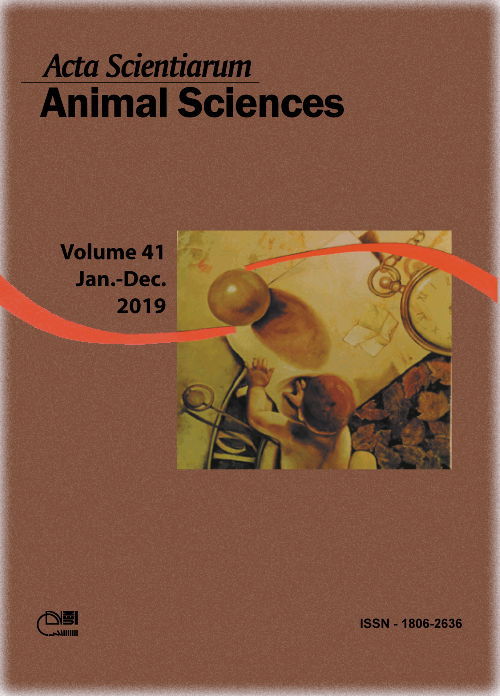Royal jelly production in Africanized colonies with selected queens, use of Chinese model cups and supplementation
Resumo
This research was carried out to evaluate the royal jelly production in two trials. In Trial I, three genotypes of Africanized honeybees (Apis mellifera L.) were submitted to royal jelly production with two types of cups of different size and volume (conventional and Chinese model) and two types of supplements (commercial and formulated). A total of 24 colonies were used, two bars with different cups each, alternating between the upper or lower position of the frame. While in Trial II, 18 colonies, two genotypes, two types of cups and two types of supplement were tested. The evaluated parameters were: percentage of larvae accepted in upper and lower bars, royal jelly per cup (mg), and royal jelly per colony/collection (g). Chinese cups were not well accepted, fact that influenced in a negative way the production of general form, selected colonies were more sensible to the change of cups. Colonies of Africanized honeybees are not prepared to produce in cups of greater volume.
Downloads
Referências
Abd Al-Fattah, M. A., EI-Basiony, M. N., & Mahfouz, H. M. (2003). Some environmental factors affecting the quality of artificial reared queens (Apis mellifera L.) in North Sinai region, Egypt. Journal of Agricultural Science Mansoura University, 28(8), 6407-6417.
Ament, S. A., Wang, Y., & Robinson, G. E. (2010). Nutritional regulation of division of labor in honey bees: toward a systems biology perspective. Wiley Interdisciplinary Reviews: Systems Biology and Medicine, 2(5), 566-576. doi: 10.1002/wsbm.73.
Blomstedt, W. (2013). A curious beekeeper travels through China Part III royal jelly production and science. American Bee Journal, 153(11), 1171-1175.
Chen, S., Su, S., & Lin, X. (2002). An introduction to high-yielding royal jelly production methods in China. Bee World, 83(2), 69-77. doi: 10.1080/0005772X.2002.11099543.
Costa, F. M., Miranda, S. B., Toledo, V. A. A., Ruvolo-Takasusuki, M. C. C., Chiari, W. C., & Hashimoto, J. H. (2007). Desenvolvimento de colônias de abelhas Apis mellifera africanizadas na região de Maringá, Estado do Paraná. Acta Scientiarum. Animal Sciences, 29(1), 101-108. doi: 10.4025/actascianimsci.v29i1.265
Doolittle, D. J., Rahn, C. A., Burger, G. T., Lee, C. K., Reed, B., Riccio, E., ... Hayes, A. W. (1989). Effect of cooking methods on the mutagenicity of food and on urinary mutagenicity of human consumers. Food and Chemical Toxicology, 27(10), 657-666. doi: 10.1016/0278-6915(89)90120-8
Faquinello, P., Toledo, V. A. A., Martins, E. N., Oliveira, C. A. L., Sereia, M. J., Costa-Maia, F. M., & Ruvolo-Takasusuki, M. (2011). Parameters for royal jelly production in Africanized honeybees. Sociobiology, 57(3), 495-509.
Feng, M., Fang, Y., & Li, J. (2009). Proteomic analysis of honeybee worker (Apis mellifera) hypopharyngeal gland development. BMC Genomics, 10(645), 1-12. doi: 10.1186/1471-2164-10-645.
Garcia, R. C., & Nogueira-Couto, R. H. (2005). Produção de geléia real por abelhas Apis mellifera italianas, africanizadas e descendentes de seus cruzamentos. Acta Scientiarum. Animal Sciences, 27(1), 17-22. doi: 10.4025/actascianimsci.v27i1.1254.
Jianke, L., & Aiping, W. (2005). Comprehensive technology for maximizing royal jelly production. American Bee Journal, 145(8), 661-664.
Khan, A. S., Matos, V. D., & Lima, P. V. P. S. (2009). Desempenho da apicultura no estado do Ceará: competitividade, nível tecnológico e fatores condicionantes. Revista de Economia e Sociologia Rural, 47(3), 651-676. doi: 10.1590/S0103-20032009000300006.
Medrzycki, P., Sgolastra, F., Bortolotti, L., Bogo, G., Tosi, S., Padovani, E., ... Sabatini, A. G. (2010). Influence of brood rearing temperature on honey bee development and susceptibility to poisoning by pesticides. Journal of Apicultural Research, 49(1), 52-59. doi: 10.3896/IBRA.1.49.1.07.
R Development Core Team. (2018). R: a language and environment for statistical computing. Vienna, AT: R Foundation for Statistical Computing.
Şahinler, N., Gül, A., & Şahin, A. (2005). Vitamin E supplement in honey bee colonies to increase cell acceptance rate and royal jelly production. Journal of Apicultural Research, 44(2), 58-60. doi: 10.1080/00218839.2005.11101149.
Sereia, M. J., Toledo, V. A. A., Faquinello, P., Costa-Maia, F. M., Castro, d. S., Ruvolo-Takasusuki, M. C. C., & Furlan, A. C. (2010a). Lifespan of Africanized honey bees fed with various proteic supplements. Journal of Apicultural Science, 54(2), 37-49.
Sereia, M. J., Toledo, V. A. A., Ruvolo-Takasusuki, M. C. C., Sekine, E. S., Faquinello, P., & Maia, F. M. C. (2010b). Viabilidade financeira da produção de geleia real com abelhas africanizadas suplementadas com diferentes nutrientes. Acta Scientiarum. Animal Sciences, 32(4), 467-474. doi: 10.4025/actascianimsci.v32i4.7895.
Sereia, M. J., Toledo, V. A. A. d., Furlan, A. C., Faquinello, P., Maia, F. M. C., & Wielewski, P. (2013). Alternative sources of supplements for Africanized honeybees submitted to royal jelly production. Acta Scientiarum. Animal Sciences, 35(2), 165-171. doi: 10.4025/actascianimsci.v35i2.16976.
Toledo, V. A. A., Alves, E. M., Oliveira, J. R., Ruvolo-Takasusuki, M. C. C., & Faquinello, P. (2010). Produção de geleia real em colônias de abelhas africanizadas considerando diferentes suplementos proteicos e a influência de fatores ambientais. Acta Scientiarum. Animal Sciences, 32(1), 93-100. doi: 10.4025/actascianimsci.v32i1.6836.
Toledo, V. A. A., & Mouro, G. F. (2005). Produção de geleia real com abelhas africanizadas selecionadas e cárnicas híbridas. Revista Brasileira de Zootecnia, 34(6), 2085-2092. doi: 10.1590/S1516-35982005000600034.
Toledo, V. A. A., Nogueira-Couto, R. H., Malheiros, E. B., Faquinello, P., & Sereia, M. J. (2012). Produção de realeiras em colônia híbridas de Apis mellifera L. e longevidade de rainhas. Global Science and Technology, 5(2), 176-185.
DECLARAÇÃO DE ORIGINALIDADE E DIREITOS AUTORAIS
Declaro que o presente artigo é original, não tendo sido submetido à publicação em qualquer outro periódico nacional ou internacional, quer seja em parte ou em sua totalidade.
Os direitos autorais pertencem exclusivamente aos autores. Os direitos de licenciamento utilizados pelo periódico é a licença Creative Commons Attribution 4.0 (CC BY 4.0): são permitidos o compartilhamento (cópia e distribuição do material em qualqer meio ou formato) e adaptação (remix, transformação e criação de material a partir do conteúdo assim licenciado para quaisquer fins, inclusive comerciais.
Recomenda-se a leitura desse link para maiores informações sobre o tema: fornecimento de créditos e referências de forma correta, entre outros detalhes cruciais para uso adequado do material licenciado.








































